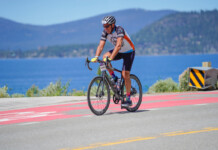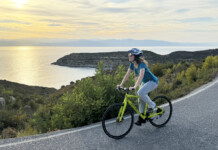By Lou Melini
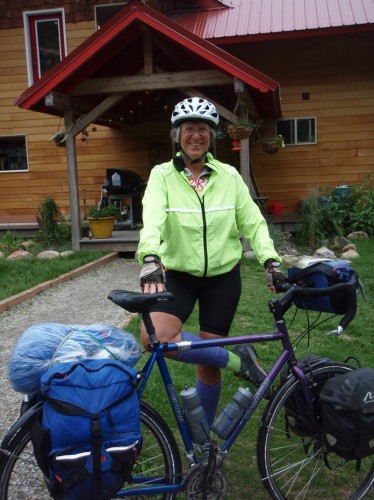
Soshnik.
I first met Cheryl Soshnik in 2007. She has been a valuable partner since the 1st annual “Rendezvous at RockCliff”, an annual bike tour we have be producing every year since 2007. Cheryl did her first long bike tour in 1975, the year I did my first multi-month tour. A lot has changed in the bike-touring world since that time though some things never change. You still need attitude and time, but most everything else has changed. I am honored to have Cheryl, from Park City, Utah, as my first subject for my new column profiling people that travel self-supported on their bicycle.
Cycling Utah. Cheryl, tell me about your first long bike tour. When and how it came about?
Cheryl Soshnik: My first long tour was the final segment of the Big Adventure of the Summer of 1975 that included many new and exciting modes of transportation. Beginning in June of that year, my husband-to-be and I had hopped freight trains and hitchhiked from Minnesota to the West Coast to backpack the Shipwreck Trail of Vancouver Island. We also backpacked in the Olympic National Park in the state of Washington. We then hitchhiked to Glacier National Park, where in addition to more backpacking, we found a willing clergyman and got married overlooking St. Mary’s Lake in Glacier National Park. The next morning, we loaded the entire wedding party onto the fast freight from Whitefish Montana back to Minnesota, where we put away the backpacks, picked up our bicycles, and began our 5-week, 2,500-mile bicycle-touring honeymoon. My (now official) husband had previously bicycle toured from his home near Stillwater, Minnesota to his summer job at Glacier National Park, but I had only gone on a couple of overnighters around Minnesota and Wisconsin.
C.U.: In 1975 I used a Sears bicycle and had to travel nearly 100 miles from my home in southern New Jersey to obtain suitable rear panniers. What type of bike and equipment did you have for the bike tour?
C.S.: I don’t think I knew anything about special touring bicycles in 1975. We installed front and rear racks on my 10-speed Peugeot. I created a set of my own panniers, sewing cordura fabric on my home sewing machine and using a friend’s commercial panniers for guidelines. For the stiffener backing, I used leftover fiberglass and epoxy resin from a prior homemade canoe project. Webbing snaps and seam sealer completed the project. They worked great, and I still have them in my camping closet, in case someone wants to borrow a set to try out bike touring.
The bikes, components, racks and panniers now-a-days are much better then in the past!!
C.U.: I used state maps that I picked up at each border. What navigation aides (maps) did you use for your trip?
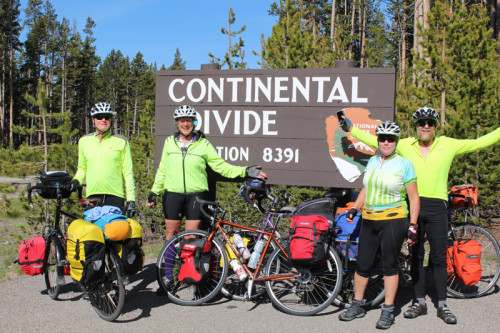
left to right: Dave Rumbellow, Cheryl Soshnik, Karen Baker-Jarvis, Rob
Jones. Taken: June 25, 2014. Photo by Lou Melini
C.S.: We also used road maps only. We knew our final destination was St. John, Newfoundland, and we knew we wanted to pass through Niagara Falls, NY…it was our honeymoon, after all! I also wanted to see Quebec City. We just figured out a route with those intermediate points in mind, and used local road maps.
C.U.: 4. What other accessories on your bike and for camp did you have?
C.S.: We both had front and rear racks, I don’t think either of us had fenders. We just got wet in the rain and it rained a lot. I did not have a helmet. My new husband had bike raced a bit, and had one of those leather helmets with lots of open space between the pads. We had good rain gear, and really nice lightweight North Face down sleeping bags that got wet and soggy and were worthless most of the trip. We had a woefully inadequate tube tent, cheap and lightweight, but worthless in the constant rain. We had a sterno stove for cooking. Made coffee in the morning, and a lot of soup at night. We would stop at grocery stores and buy food for our (mostly wild) camping evenings. Today’s stoves, tents, and anything on the bike or for camping is much better than 1975.
C.U.: What “cycling” clothing did you wear in 1975?
C.S.: Probably like you, I rode in cut-off jeans. One improvement for cycle travelers is the clothing is much more enjoyable to ride in vs. the cut-off jeans. .
C.U.: I tell people that my cross-country ride was life changing. How did that trip influence your life?
C.S.: I was doing a lot at that time so the bike trip didn’t really influence my life very much for me, it wasn’t a life changing experience. It was just one more adventure to chalk up on the list of very exciting adventures we were already having. After this tour, I put away the panniers and didn’t take them out again for 20 years, when I began touring again in earnest. Being a social person bicycle touring has opened up my opportunities to meet others. So now the touring bike and panniers are used constantly!
C.U.: What were some of the tours you have done since that 1975 trip? Were some of the tours more memorable than others? Were some complete disasters?
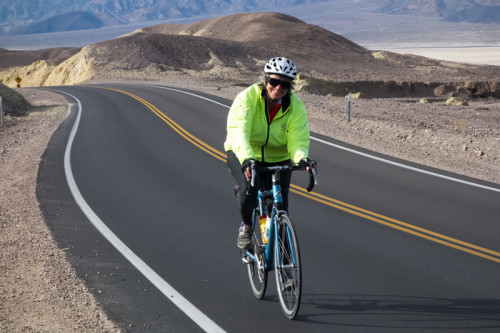
C.S.: I have done a lot of extended touring since 1995, when my life and my job allowed me large chunks of time off. Internationally, I have toured twice in France, twice in New Zealand, and once each in Tasmania, Ireland, and Italy. These trips were between two weeks and two months in length. In North America, I have also done quite a few one to two week tours, from the Selkirk Loop (Idaho, British Columbia, and Washington) to yearly tours that I organize for the Wasatch Mountain Club in Utah and Idaho.
As far as disasters, I learned the hard way on my very first international tour, that credit card touring does not always work out if you don’t have prior reservations.
This happened along the Cote d’Azure in France: it was late May, and since we planned to grab a hotel every night, we did not bring sleeping bags or tents, nor anything that would work as a bivvy sack in case of an emergency. What we were not aware of was that the Cannes Film Festival was just about to begin, and we were getting closer and closer to Cannes. When we got to Cassis, we had a lovely lunch at the seashore, and then proceeded to the tourist bureau to have them find us a hotel. Oops, there were none to be had in that small town. They suggested we take the train to the next larger town, Toulon. So we did, not getting there until the evening, and finding that we were even closer to Cannes, so even though the town was larger, there was not a room to be had. In Toulon, we finally figured out why we were striking out on finding hotels, as we were now only 60 miles West of Cannes.
We decided to get out of the area, to take the train all the way to Nice, then bike from there. However, the next train would not arrive until 5 AM, and they kicked us out of the train station at 11 PM for the night. We ended up sleeping on the concrete steps of the city center train station, covering up with our jackets and ponchos while taxis buzzed by and locals walked the sidewalks around us in the night. We survived, took the early morning train to Nice, played tourist for a couple days, bicycling back to Cannes after the festival was over. I have never toured without sleeping bag and tent ever again!
C.U.: What have been the most valuable improvements for bicycle travelers in the past, say, 20 years.
C.U.: I mentioned earlier that bikes, components, clothing and camping equipment has improved immensely. There are a lot of other improvements that have been life and money savers, mainly Warmshowers (warmshowers.org) and S&S couplers (a system to allow a bike frame to be split in two for easier shipping). For lodging, both the increased number of backpacker hostels and the number of folks who open their homes to touring cyclists via Warmshowers, have made “wild” camping almost a thing of the past for me. Plus, as one gets older, it’s not quite as fun to wait until dark, then find an out of the way spot to stealthily set up a camp for the night. You kind of like a roof over your head, a bed, a nice shower, and friendly locals to visit with. I have made lifelong friends with my Warmshowers contacts around the globe, and I also enjoy hosting other touring cyclists as they venture through Park City over the years.
I have had my CoMotion touring bike with S&S couplers now since 2004, and I can’t imagine touring without a custom bike setup any more. When I first had to take my bike apart and pack it in the Cordura suit case for airline travel, my heart was pounding and sweat was pouring off my forehead. I photographed all the parts and how they had to go together again, but it was still a scary adventure to disassemble and reassemble a bicycle again at your destination. Now that I’ve gone through this procedure a dozen or more times, it’s easier, but still not easy. But it’s worth the stress, being able to travel with a bicycle as one piece of regular luggage. The airline fees for transporting bicycles are outrageous, and even then I hear horror stories of bikes being broken or bent in transport. I have never had one issue with damaged or lost parts of the bicycle with this method of transport, and I have never had to pay the bicycle surcharge on airlines.
C.U.: Describe your typical extended bike tour.
C.S.: First of all, I usually bike with just one other person on these long trips. My nomadic buddy Randy is my usual touring partner…low keyed and flexible with changing plans as the trip plays out. Next, we’ll get our plane ticket, so our dates and start/ending destination are locked in. I have always done loop trips when travelling internationally. Ahead of time, I will book our first night’s lodging at a hostel or WarmShowers host near the airport. We will use this location as our base to assemble the bikes, leave the bike bags and duffels, and then return there again the night before our return flight, to retrieve the bags and break down the bikes again.
Once ready to roll, we just start biking, heading towards some of the locations I had researched ahead of time, but being flexible enough to change plans if needed. We look for hostels or campgrounds for lodging, but will wild camp if the weather is nice and the bugs aren’t too bad. We carry a MSR stove and cook out for breakfast and dinner, getting a restaurant meal at the lunch town.
One of our biggest worries is finding a happy hour pub for my buddy Randy at 5pm every day!
In New Zealand and Tasmania, we carried lightweight backpacks and hiking boots, as we biked for a few days, then stored the bikes at a local campground as we climbed volcanoes or tramped 3-4 days on world famous tracks such as the Queen Charlotte or Milford. These serendipitous adventures are priceless, and we have always made it back to the airport on time, although sometimes it was a close call.
C.U.: What is it about traveling by bike that intrigues you to have been doing it for so long?
C.S.: I tell this to everyone I meet, when they ask why I love to bike tour so much: The very best way to see the world, to meet the locals, to experience a new country is on your touring bike. The locals are more open to tourists on a bicycle than one who gets off of a bus or who passes by in a car. In the hostels, you meet like-minded folks from all over the globe. You share stories from past trips, and walk away with ideas for new trips. You discover from the locals or from fellow bike tourers the hidden gems of places to visit or foods to eat that a normal tourist would never know about. If you truly want to experience a new place in the world, do it on your touring bike…oh and keep an open mind for those new experiences!
C.U.: You’ve done all of your trips self-supported. Have you ever done a commercial tour where your bags are carried for you?
C.S.: I have used the brochures from commercial companies such as Vermont Bicycle Tours as resource materials to give me ideas of places to visit. After many years receiving the VBT catalog, I actually did a tour with them to Poland last fall. I hate to say this but at my age (same as you Lou) it was nice. My ancestors are from Poland so I was able to visit places from my heritage. It was really nice to have two wonderful native Polish guides for translation, to the local customs, or to help us navigate the local outdoor markets. We had Polish lessons every morning before biking, and then we tried out our new phrases on the locals as we bicycled through the beautiful countryside and historic towns. I enjoyed the other guests on the tour, the 4-star hotels, the ethnic cafes, the cooking class, and the organized tours of museums, WWII sites, and touring the underground salt mines. Bottom line, I enjoyed the ride without having to do the work of planning, organizing, or toting all my gear on my own. Yes, it was pricier than my self-supported tours but for treat, it was well worth it.
My other notable supported ride occurred several years ago, when a SLC friend who is originally from Morocco, organized a sightseeing-bicycling tour of Morocco for 32 of her closest friends. It wasn’t a commercial tour, but Mounia enlisted the help of her father, sister and brother to plan and accompany us throughout their home country. We rented bicycles from her dad, who just happened to own a bicycle shop in Meknes, and biked through small towns and the Sahara Desert on our way to our overnight camel adventure.
C.U.: Have you used navigation aides such as Garmin?
C.U.: I haven’t. GPS and those aides are helpful but people are missing out on great alternate routes. I don’t even have a computer on my bike anymore. WarmShowers, and even Facebook and the internet in general have lots of information via blogs. There is Crazy-Guy-on-a-Bike (crazyguyonabike.com) to help get you onto the back roads. Sometimes I contact touring groups to help out in areas I plan to tour in, especially overseas.
C.U.: What is on your future bucket list for bike travel?
C.S.: Next summer, I hope to spend 6 weeks bike touring in Scotland, Wales and Northern England. I’ve had the trip roughed out now for a couple years. After that, I think a third trip to New Zealand is in order. I wouldn’t mind going back to Ireland again, or back to Tasmania again either. At this time of my life, I would prefer touring in English speaking countries. If not then I would like to have someone that speaks the language to act as a translator. So many trips, so little time!
C.U.: Cheryl, thank you for your time. I know we hustled to get this column completed. Have fun at another RAGBRAI event.




